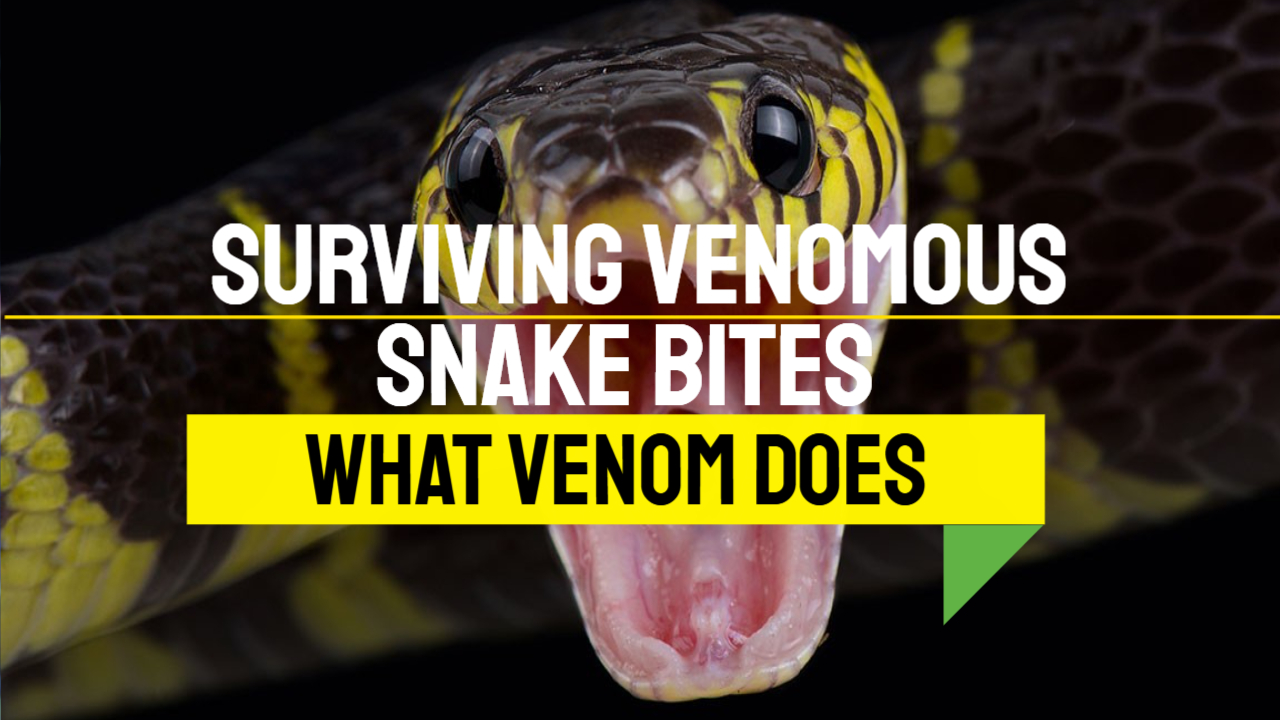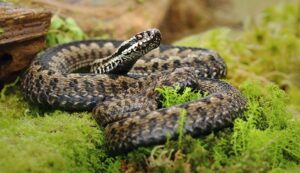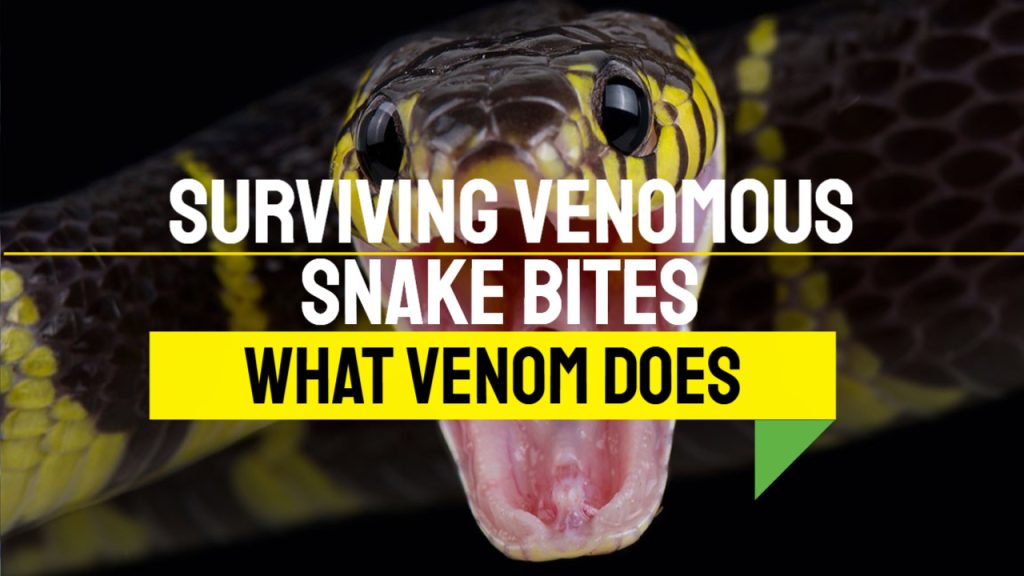Unveiling the Enigma: Understanding the Impact of Venomous Snake Bites
The Stealthy Threat of Snake Venom
Although snakebites may not seem like a huge matter, they cause over 100,000 deaths annually and are a critical worldwide health issue that is frequently ignored. By elucidating the intricacies of snake venom and emphasising the significance of increasing awareness and taking prompt action following a snake bite, this essay seeks to raise awareness of this hidden threat.
Snakebites impact a broader spectrum of international health issues in addition to the physical symptoms that afflict the victims. Despite the startlingly high death rate associated with these bites, they are frequently disregarded in favour of more widely recognised health dangers. This oversight has delayed down reactions and, in many cases, resulted in avoidable deaths by making it more difficult for people to grasp.
The evolution of snake venom over time can be observed by examining its historical development. Venom has evolved over a hundred times on its own, demonstrating its remarkable adaptability to various species. Snake venom is a complex biochemical toolkit with a wide range of applications, including self-defense and its primary role as a predator. Comprehending these genetic origins is crucial to comprehending the intricacies of snakebite injuries and creating efficacious strategies to prevent them from occurring.
Studies on the uses of snake venom reveal that its applications are not limited to hunting and self-defense. During the breeding season, tawny crazy ants employ venom as a remedy, and male platypuses use their toxic spurs to compete. This demonstrates the complexity and versatility of these biochemical combinations.
The need for prompt action becomes increasingly evident as we understand more about the evolution of snake venom. The distinct workings and consequences of several snake venoms will be elucidated in this article. The necessity of giving antivenom as soon as possible to avoid potentially catastrophic consequences will also be emphasised throughout the paper. Long-term harm can be minimised and lives can be saved during this crucial window of time.
The Intricate Purpose of Snake Venom
A remarkable evolution, venom has been observed in numerous species, each of which has evolved to fulfil a distinct and intricate function. Understanding poisonous snakes better demonstrates the wonders of evolution brought about by this biochemical concoction that is the product of nature's ceaseless inventiveness.
Approximately 700 venomous snakes with front fangs use their poison to hunt and protect themselves. Among their survival methods, this is one of the most crucial elements. These snake-like predators, which are primarily members of the Elapidae and Viperidae families, have evolved venom as a potent tool for swiftly capturing prey. These snakes have spent thousands of years honing their sophisticated venom, which allows them to swiftly incapacitate or kill their prey, ending the hunt and giving them energy and food.
These snakes have a powerful defence mechanism in their venom, which also keeps them from being eaten. Venom is a potent deterrent that makes a strong statement to potential assailants when it comes to potential predators or hazards. This defensive application of venom demonstrates how adaptive it is, providing snakes with a potent means of defending themselves against threatening circumstances and navigating their surroundings.
The venom of the 1,800 additional species in the Colubridae family that have back wings is not as potent as that of the species with front wings. Though there are rare exceptions, most snakes don't represent much of a hazard to humans with their venoms. This demonstrates how various snake species employ various tactics in various ecological settings.
The way venom has developed and become a crucial component of survival illustrates how the relationship between predators and prey has changed throughout nature. It tells a lot about these critters that they can adapt so well, honing their biological weapons to suit the demands of their environment. Understanding the purpose of venom helps us understand the behaviour of snakes and the broader evolutionary processes that have shaped species throughout history.

The Varied Arsenal: What Venom Does
The variety of venoms in nature allows us to understand the complexity of its biology. Not all venoms have the same effects; rather, they vary widely in ways that are specific to the requirements and strategies of the snakes that employ them.

Adders and rattlesnakes are included in the subgroup of vipers considered dangerous. It is well known that their venoms are hemotoxic. These venoms target the circulatory system, triggering a series of reactions that may result in bleeding or impede the healing of haemorrhage. The victim's body reacts more complexly since it affects the blood system, which could have catastrophic consequences if treatment is delayed. For those who have been bitten by these animals, developing effective treatment programmes requires an understanding of how hemotoxic viper venom works.
The elapids, which include mambas and cobras, on the other hand, exhibit a distinct aspect of venom complexity. Most of their venoms are neurotoxic, which means they interfere with nerve signals and immobilise their victims. Elapids are intelligent predators who attempt to control their prey while rapidly decreasing the likelihood of a counterattack, as demonstrated by this neurotoxicity. Neurotoxic venom does not just render you immobile. It frequently causes rapid unconsciousness, which aids snakes in their ability to hunt.
Venoms come in two varieties: those that damage nerve cells and those that destroy blood cells. This demonstrates how elapids and vipers have evolved to occupy various biological niches. It also highlights the significance of tailoring medical interventions to the specific effects of each type of venom and the necessity for a thorough understanding of the pathophysiology of snakebites. Our knowledge of the intricate impacts of venom deepens our comprehension of the unusual survival strategies that these fascinating species have developed.
Beyond Convention: Uncommon Venom Applications
Beyond its typical uses in defence and hunting, venom has an incredible life cycle that demonstrates the variety of ways in which animals might employ it. Although venom is often thought of as a lethal weapon, it is actually a biochemical mixture with a wide range of applications.
The most well-known individuals with unusual alterations are male platypuses. During the breeding season, these unique monotremes employ their venomous spurs on their rear legs for violent rivalry rather than for hunting or defence. To establish their dominance and secure the right to mate, male platypuses engage in fierce combat and brandish their venomous spurs. The unique way these fascinating animals compete by using their venom as a weapon adds even more intricacy to their reproductive system.
Looking at insects, we find an unexpected connection between venom and tawny mad ants. These resilient ants employ their venom as a defence against the fire ant, their most formidable foe, rather than as a tool. Like in chemical warfare, tawny crazy ants utilise their own poison to neutralise the destructive effects of fire ant venom. This demonstrates how perceptive and intelligent they are in their interactions with their surroundings.
Some animals, such as shrews, also employ venom as a means of survival. It is thought that these tiny creatures employ a unique method of food preservation with their venom. Shrew venom's antibacterial qualities might prevent captured prey from decomposing owing to germs, allowing it to be utilised as a reasonably fresh food source in the future. The unique way in which these tiny predators store food with their venom adds an intriguing new dimension to their complexity.
Why Some Snakes Are Deadlier
Because of the intricate organisation of deadly snakes, no two bites are alike. Certain species possess extremely potent venoms that render them fully lethal. The inland taipan and the black mamba are two snakes that eloquently illustrate this tendency. The potency of their venoms demonstrates how prey and predators have developed defensive mechanisms over time.

Native to sub-Saharan Africa, the black mamba (Dendroaspis polylepis) is frequently included among the snakes with the highest venom content worldwide. Its venom is a complex mixture of cardiotoxins, neurotoxins, and other enzymes that combine to quickly and severely harm its victim. The black mamba's venom is well-known due to its potency, swiftness, and precision in administering several bites. The black mamba is a deadly predator that guarantees its prey suffers immediate and irreversible harm due to this lethal combination.
Only found in arid regions of Australia, the inland taipan (Oxyuranus microlepidotus) is the most deadly snake in the world. Its venom is a potent mixture of neurotoxins that target the central nervous system, causing paralysis and stopping breathing. The inland taipan is a solitary species that seldom attacks humans, despite its frightening appearance. However, its venom is expertly crafted to swiftly dispatch its prey, which primarily consists of small mammals and birds.
These venoms are lethal because they have adapted to swiftly incapacitate their victims. To survive in the ever-changing settings these snakes inhabit, they must locate food rapidly and avoid potential threats. Predators have created venoms that successfully and swiftly immobilise their prey since they must kill them rapidly. This aids them in winning the never-ending struggle for survival.
Comprehending the potent venoms of serpents such as the inland taipan and black mamba enhances our comprehension of the intricate dynamics that exist between predators and prey. It demonstrates how these slithering predators have developed into formidable and skillful hunters.
Race Against Time: Curing Snakebites
When a snake bites a person, time is of the essence, and administering antivenom is the most crucial step in saving their life. It is more difficult to preserve lives when one must decide between monovalent and polyvalent antivenoms. This leads to issues highlighting how crucial it is to accurately diagnose snakes to receive targeted and efficient treatment.
A human bitten by a snake is shielded from the deadly effects of the venom by antivenom, which is created from the blood of animals that have been immunized against snake venom. It is critical to respond quickly to prevent or reduce the potentially fatal effects of envenomation. Conversely, selecting the appropriate antivenom is a customized process.
One-species antivenoms are designed to combat a specific type of snake's venom. Monovalent antivenom requires knowledge about the precise kind of snake that bit the victim in order to function. Because even the venom from closely related snake species can differ greatly in composition, achieving this accuracy becomes challenging. The venoms of the same species can vary geographically, adding to the complexity of the situation. This demonstrates how crucial it is to accurately identify snakes to receive the best possible care.
Conversely, polyvalent antivenoms are designed to combat the venoms of multiple snake species. Although polyvalent antivenoms cover a greater number of insects, they have a drawback. The components required to neutralise the various poisons in the mixture of venoms may reduce the antivenom's efficacy in treating a particular snake bite. This makes things more difficult for physicians, who must carefully balance the advantages of polyvalent antivenoms against the possibility that they won't be as effective against specific venoms.
Snakebite treatment must be done promptly, highlighting the need for improved medical infrastructure, more accessible healthcare facilities, and increased awareness in places where snakebites are widespread. Additionally, additional research is required to enhance antivenom formulations and provide more specialized treatment programs, resulting in improved results for snakebite patients across the globe.
Beyond Venom: Snake Venoms in Medicine
Although the strength of their venom makes them generally feared, snakes are also essential to advancing medicine. This paradigm shift investigates the potential impact of snake venom on healthcare and may result in novel therapeutic discoveries. Researchers have discovered many intriguing applications for these complex molecular mixtures that have the potential to alter the practice of medicine fundamentally.
A well-known example of snake venom being utilized for further medical research involves the saliva of the Gila monster, a deadly lizard found in the southwest region of the United States. The venom of the Gila monster contains a peptide that resembles the hormone exendin-4. Its structure is comparable to that of human GLP-1, or glucagon-like peptide. This commonality has led to the development of diabetes medications that use exendin-4 analogs, such as exenatide, to help improve blood sugar regulation. The poisonous addition of the Gila monster demonstrates how nature's biochemical innovations can assist in resolving significant health issues in humans.
Angiotensin-converting enzyme (ACE) medications such as captopril are used to treat congestive heart failure and excessive blood pressure. Captopril originated from the venom of the South American jararaca snake, or Bothrops jararaca. This snake's venom contains a peptide that inhibits the function of ACE, a crucial enzyme for blood pressure regulation. With rigorous research and isolation, scientists have transformed this deadly chemical into a medication that can save lives. This demonstrates the vast unrealized potential of snake venom.
These are but a few instances of the intricate biochemical compounds that are present in snake venom that may have therapeutic applications. The intricacy and diversity of these venoms serve as enormous “bio-libraries,” providing researchers with a wealth of inspiration for creating novel medications. More components of snake venom will probably be discovered and employed as the field of toxin research expands. This reinforces the theory that the most hazardous animals in nature may have the secret to saving lives and could lead to new approaches to treating ailments.
References
- Mackessy, S. P. (Ed.). (2009). Handbook of Venoms and Toxins of Reptiles. CRC Press.
- This comprehensive handbook provides in-depth information on the biochemistry and pharmacology of reptile venoms, including those of snakes.
- Fry, B. G. (Ed.). (2015). Venomous Reptiles and Their Toxins: Evolution, Pathophysiology, and Biodiscovery. Oxford University Press.
- Edited by Bryan Grieg Fry, this book delves into venomous reptiles’ evolution, physiology, and medical applications, offering a broad perspective.
- Weinstein, S. A., & White, J. (Eds.). (2013). Clinical Toxinology in Asia Pacific and Africa. Springer.
- This book focuses on the clinical aspects of envenomation in the Asia Pacific and Africa regions, providing insights into snakebite management and antivenom use.
- Kasturiratne, A., Wickremasinghe, A. R., de Silva, N., Gunawardena, N. K., Pathmeswaran, A., Premaratna, R., … & Lalloo, D. G. (2008). The Global Burden of Snakebite: A Literature Analysis and Modelling Based on Regional Estimates of Envenoming and Deaths. PLOS Medicine, 5(11), e218.
- This research paper provides a global perspective on the burden of snakebite, offering insights into the prevalence and impact of snake envenoming.
- Chippaux, J. P. (1998). Snake-bites: Appraisal of the global situation. Bulletin of the World Health Organization, 76(5), 515–524.
- An article provides an overview and assessment of the global snakebite situation, highlighting the importance of addressing this public health issue.
The Post Surviving Snake Venom: Unraveling The Impact appeared first on Survival Bite.
The Article Surviving Snake Venom: Unraveling The Impact was found on https://limitsofstrategy.com



It’s interesting how snake bites don’t get the attention they deserve when you think about their impact worldwide. Living in a rural area, I’ve seen firsthand how folks often underestimate the risk, dismissing it because it feels remote or unrelated to their daily lives. It’s not just about the immediate danger though; the lack of awareness can have long-term implications for healthcare systems, especially in developing regions where antivenom may not be readily available.
You raise a crucial point about the often-overlooked issue of snake bites, particularly in rural areas. It’s interesting how our perception of risk can be so shaped by our experiences. For many, the danger of snake bites feels distant, almost like it belongs to a different world. Yet, for those living in rural communities where encounters are more frequent, it becomes a part of daily life. It’s alarming to think about how this disconnect can lead to underestimating the real risks and consequences.
“Discover a heartfelt resource that beautifully encapsulates the journey many of us share, offering support and understanding when we need it most—click here to explore and connect.”
https://ezinetwork.org/octopus
You bring up such an important perspective on the issue of snake bites and the disparities in how we perceive risks based on our environments. Living in a rural area certainly reshapes one’s understanding of these dangers. I remember hearing stories from my grandfather about how common snake encounters were on his farm. While those tales felt so distant from my own life in the city, they highlighted a reality that many people face daily.
You’ve touched on a significant point about how environment shapes our perceptions of risk. Growing up in different settings creates unique experiences that influence how we approach dangers like snake bites. Your grandfather’s stories are vivid links to a world where encounters with snakes were just part of daily life. In rural areas, the regular interaction with nature means people are often more accustomed to dealing with its unpredictability, including snakes.
You make a really compelling observation about the disparity in perceptions of risk, especially when it comes to something as unpredictable and often overlooked as snake bites. It’s true that our individual experiences heavily shape how we view risks. For many of us in urban settings, the thought of encountering a snake seems remote, something that only pops up in nature documentaries or horror films. But for those in rural communities, it’s a daily concern that can carry serious consequences.
You bring up an important point about snake bites and the often-overlooked risk they pose, particularly in rural areas. It’s interesting how something as potentially dangerous as a snake bite can seem so distant for many until it strikes close to home. People tend to underestimate the impact because it doesn’t happen every day, but for those living in areas where snake encounters are more common, the threat is very real.
“Explore the insights and expertise we’ve compiled in our latest resource, designed to elevate your understanding and support your decision-making process.”
https://ezinetwork.org/quillbot
You raise some solid points about snake bites and the general apathy surrounding them. Living in a rural area gives you a unique perspective that many urban dwellers overlook. It’s true that people often see snake bites as an isolated issue, something that might only happen “out there” in the wild, not recognizing the very real danger that creeps into everyday life.
You’ve touched on a critical issue that often flies under the radar. It’s wild to think how snake bites, despite their significant impact, hardly make headlines like other health crises do. Living in a rural area gives you a front-row seat to the complexities of this situation. When people live in close proximity to nature, the risk can feel more tangible, yet many still brush it aside.
You’re right—it’s pretty surprising how little attention snake bites get in the broader health conversation. Living in a rural area certainly changes your perspective on these risks. I often think about how our interactions with nature are so deep and complex; they come with both beauty and danger.
You bring up a really important point about snake bites and how they often get overlooked compared to other health issues. It’s interesting how certain risks become normalized in rural areas, almost like background noise, right? Living close to nature definitely creates a different relationship with these kinds of hazards.
You’re totally spot on about how snake bites often become this overlooked risk, especially in rural areas. It’s fascinating how people who live close to nature develop this sort of acceptance of the hazards—it really speaks to the resilience and adaptability of communities. I remember when I got my first job on a small farm, I was shocked at how casually we approached safety around wildlife. It was almost like a rite of passage to know how to handle encounters with snakes or other critters.
You’ve raised an important point about the often-overlooked risks of snake bites, especially in rural areas. It’s true that for many people, snakes can seem distant or irrelevant to their daily routines. However, as you’ve witnessed firsthand, the reality is much different for those living in close proximity to these creatures. The perception of safety can lead to a dangerous complacency, which not only affects individual well-being but also the broader public health landscape.
“You’re absolutely right; the underestimation of snake bites can have serious consequences. To learn more about the hidden dangers and how we can address this issue, check out this informative resource.”
https://ezinetwork.org/octopus
You make a really good point about snake bites often flying under the radar, especially in rural communities. I’ve read about how many people view these incidents as isolated and distant, which can lead to a lack of preparedness. It’s fascinating—and a bit alarming—how our perception of risk can be so skewed based on our surroundings.
I appreciate your thoughts on this topic. It’s interesting how the perception of risk can vary so much based on where we live and our everyday experiences. In rural communities, snake bites can seem like an afterthought, overshadowed by more immediate concerns. But as you pointed out, that perception can lead to a dangerous lack of preparedness.
Absolutely, it’s crucial to shift that perception and enhance awareness. For those interested in learning more about snake bite prevention and preparedness, check out this informative resource!
https://ezinetwork.org/WildSurvive
You raise a solid point about how snake bites fly under the radar, especially in rural areas where people might feel like they’re safe from the slithery dangers lurking in the grass. It’s almost like snakes are the sneaky ninjas of the animal kingdom, quietly going about their business while we humans are off focused on more “pressing” concerns like the latest soap opera drama or which brand of avocado toast is trending.